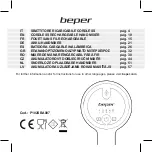
51
O
UTPUT
L
EVEL
M
ATCHING
AND
B
ALANCE
This example shows the matrix and LR2 outputs feeding the speaker system. Here all
the output controls are grouped together at the top of the panel away from the normal
operating area. Select
POST
for LR2 so that the output follows the LR faders. Adjust
LEV
to match the operating level of each amplifier to give the desired listening level with
optimum console signals (faders and meters operating around '0'). A correctly matched
system ensures the best signal-to-noise and headroom performance. The balance
between the speakers can also be adjusted using
LEV
. Press
ON
to turn on or off
selected speakers in the system, useful in checking the effect of each. Use
AFL
to
monitor each output post level control but pre ON switch.
O
UTPUT
D
RIVE
AND
I
NSERTS
Select
#
OUT REV
for interference free balanced XLR drive to the amplifiers. This
also provides an insert on each output for graphic EQ, delays and other signal
processing devices. Inserting graphics lets you tune the frequency response of each
speaker in the system for best clarity, acoustic correction and feedback reduction.
T
HE
M
ATRIX
M
IX
AND
D
ELAY
S
PEAKERS
Use the matrix to create the required mix to the delay speakers which improves the
intelligability of the sound to the rear of the audience. The balance of the group signals
to the matrix may be different to the subgroups feeding LR to ensure that the focus of
the sound is not lost. Insert a delay unit to compensate for the acoustic delay from stage
to speakers. Insert a graphic EQ to compensate for the local acoustics and to remove
some LF and HF which may distract the listener from the true source of the sound.
M
ULTI
-S
PEAKER
S
YSTEM
6 Speaker system driven from the matrix and LR2
outputs. Provides output balance and level trim
independent of the mix levels. All outputs are
balanced XLR with inserts for EQ, delay or other
signal processors.



































